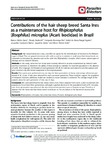Por favor, use este identificador para citar o enlazar este ítem:
http://www.alice.cnptia.embrapa.br/alice/handle/doc/1004221Registro completo de metadatos
| Campo DC | Valor | Lengua/Idioma |
|---|---|---|
| dc.contributor.author | GARCIA, M. V. | pt_BR |
| dc.contributor.author | ANDREOTTI, R. | pt_BR |
| dc.contributor.author | REIS, F. A. | pt_BR |
| dc.contributor.author | AGUIRRE, A. de A. R. | pt_BR |
| dc.contributor.author | BARROS, J. C. | pt_BR |
| dc.contributor.author | MATIAS, J. | pt_BR |
| dc.contributor.author | KOLLER, W. W. | pt_BR |
| dc.date.accessioned | 2015-01-05T11:11:11Z | pt_BR |
| dc.date.available | 2015-01-05T11:11:11Z | pt_BR |
| dc.date.created | 2015-01-05 | pt_BR |
| dc.date.issued | 2014 | pt_BR |
| dc.identifier.citation | Parasites & Vectors, London, v. 18, n. 1, p. 1-4, Nov. 2014. | pt_BR |
| dc.identifier.uri | http://www.alice.cnptia.embrapa.br/alice/handle/doc/1004221 | pt_BR |
| dc.description | Abstract: BackgroundHair sheep breeds are a new, cost-effective option for the diversification of livestock in the Midwest region of Brazil. They are grazed extensively with cattle as well as in isolation in small areas. Hair sheep breeds are vulnerable to infestation by parasites such as the cattle tick, Rhipicephalus microplus, which causes various types of damage and can transmit diseases.MethodsIn this study, Santa Inês hair sheep were naturally infested in an area contaminated by infested cattle and then monitored to determine the ability of these animals to maintain the local tick population in the absence of cattle. After engorged tick females of each generation fell off, the animals were placed in another pasture and were returned only after larvae reappeared in the original pasture.ResultsTick counts were performed every ten days for three generations of sheep, and average infestations per animal of 34, 12 and 4 ticks were observed for each successive generation. These numbers suggest the acquisition of resistance; however, additional studies are needed to ensure resistance is achieved. The average length of the parasitic phase for each generation of ticks was 25 days.ConclusionWe concluded that this hair sheep breed, even if kept separate from cattle, is able to maintain tick populations for at least three generations, although a gradual decrease in the population levels of R. microplus over three generations was observed. We also detected two positive cases of Anaplasma spp. Therefore, it appears that the Santa Inês hair sheep breed contributes to the circulation of this bacterium among other ruminants. | pt_BR |
| dc.language.iso | eng | eng |
| dc.rights | openAccess | eng |
| dc.subject | Raça Santa Inês | pt_BR |
| dc.subject | Biological cycle | pt_BR |
| dc.subject | Metastigmata | pt_BR |
| dc.title | Contributions of the woolless sheep as a host for the maintenance of Rhipicephalus (Boophilus) microplus (Acari: Ixodidae) populations in a pasture area in Brazil. | pt_BR |
| dc.type | Artigo de periódico | pt_BR |
| dc.date.updated | 2015-01-05T11:11:11Z | pt_BR |
| dc.subject.thesagro | Ovino | pt_BR |
| dc.subject.thesagro | Parasito de animal | pt_BR |
| dc.subject.thesagro | Carrapato | pt_BR |
| dc.subject.nalthesaurus | Sheep | pt_BR |
| dc.subject.nalthesaurus | Anaplasma | pt_BR |
| dc.subject.nalthesaurus | Parasites | pt_BR |
| dc.subject.nalthesaurus | Rhipicephalus microplus | pt_BR |
| dc.subject.nalthesaurus | ticks | pt_BR |
| riaa.ainfo.id | 1004221 | pt_BR |
| riaa.ainfo.lastupdate | 2015-01-05 | pt_BR |
| dc.identifier.doi | 0.1186/s13071-014-0515-5 | pt_BR |
| dc.contributor.institution | MARCOS VALÉRIO GARCIA, Molecular Biology Laboratory, Embrapa Beef Cattle, Campo Grande, MS, Brazil; RENATO ANDREOTTI E SILVA, CNPGC; FERNANDO ALVARENGA REIS, CNPC; ANDRÉ DE ABREU RANGEL AGUIRRE, Graduate Program of Infectious and Parasitic Diseases, School of Medicine, Universidade Federal de Mato Grosso do Sul, Campo Grande, MS, Brazi.; JACQUELINE CAVALCANTE BARROS, CNPGC; JAQUELINE MATIAS, Graduate Program of Infectious and Parasitic Diseases, School of Medicine, Universidade Federal de Mato Grosso do Sul (UFMS), Campo Grande, MS, Brazil.; WILSON WERNER KOLLER, CNPGC. | pt_BR |
| Aparece en las colecciones: | Artigo em periódico indexado (CNPC)  | |
Ficheros en este ítem:
| Fichero | Descripción | Tamaño | Formato | |
|---|---|---|---|---|
| apContributions.pdf | 239,11 kB | Adobe PDF |  Visualizar/Abrir |









